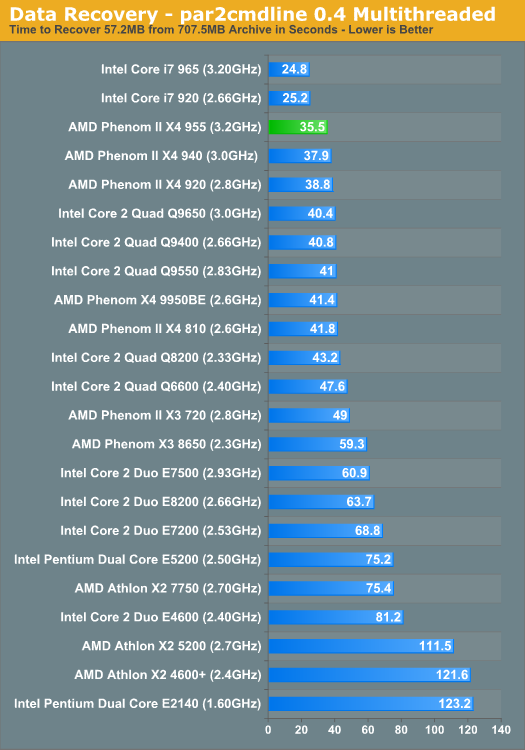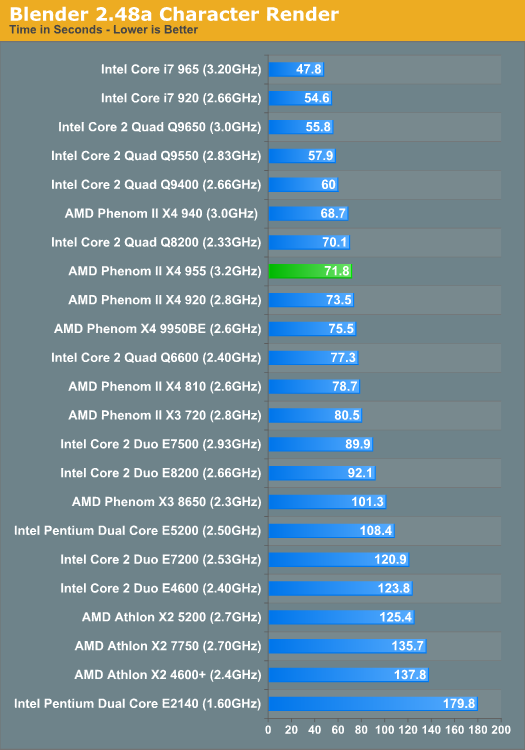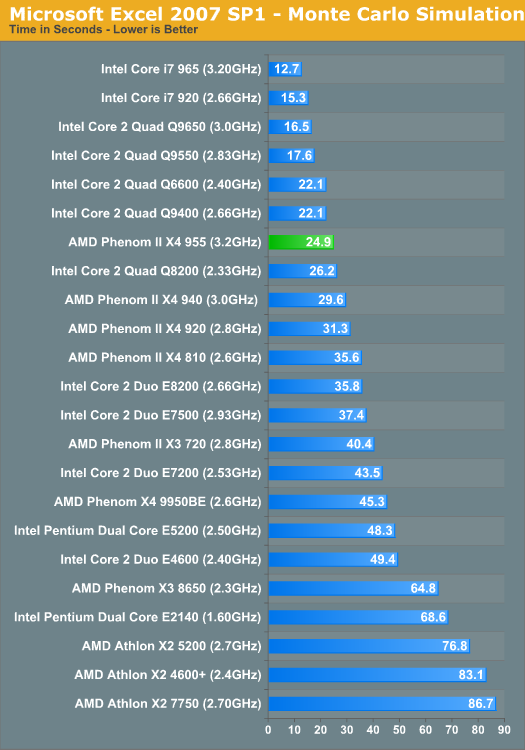AMD's Phenom II X4 955 Black Edition
by Anand Lal Shimpi on April 23, 2009 12:00 AM EST- Posted in
- CPUs
PAR2 Multithreaded Archive Recovery Performance
Par2 is an application used for reconstructing downloaded archives. It can generate parity data from a given archive and later use it to recover the archive
Chuchusoft took the source code of par2cmdline 0.4 and parallelized it using Intel’s Threading Building Blocks 2.1. The result is a version of par2cmdline that can spawn multiple threads to repair par2 archives. For this test we took a 708MB archive, corrupted nearly 60MB of it, and used the multithreaded par2cmdline to recover it. The scores reported are the repair and recover time in seconds.

AMD's Phenom II has traditionally done quite well in our PAR2 recovery test, the 955 continues the tradition. It's the i7's Hyper Threading that gives it the significant edge here, but the Q9550 can't stand a chance.
Blender 2.48a
Blender is an open source 3D modeling application. Our benchmark here simply times how long it takes to render a character that comes with the application.

This is one of those unfortunate cases where switching platforms actually robbed us of performance, the 955 should outperform the 940 here but it put out numbers a bit slower than our older AM2+ platform which unfortunately doesn't have support for the new CPU just yet. Either way, the Q9550 is too far ahead to be toyed with.
Microsoft Excel 2007
Excel can be a very powerful mathematical tool. In this benchmark we're running a Monte Carlo simulation on a very large spreadsheet of stock pricing data.

In those scenarios where Intel has a distinct architectural or optimization advantage, the Phenom II doesn't stand a chance. That is unfortunately one downside AMD has to deal with. Intel's developer relations team is much larger and works much harder to ensure that more applications and workloads are optimized as best as possible for Intel CPUs.










65 Comments
View All Comments
strikeback03 - Thursday, April 23, 2009 - link
Well, the most expensive X58 board is over $400, while the cheapest AM2+ boards are under $50, do you want them to say the range is over $350? I'd guess the thinking behind that statement was that you would pair the most expensive processor AMD sells with a higher-end board - the AMD boards top out at about $190, about where the i7 boards start (ignoring rebates).just4U - Friday, April 24, 2009 - link
It's the minimum entry level into each that I think most people would be curious about. The higher end stuff can really skyrocket the price after all and I am pretty sure it would be filled with features not likely to interest the majority.strikeback03 - Friday, April 24, 2009 - link
Again though, those who are looking to buy the 955 are probably interested in some of the stuff the better boards offer. Considering the performance available form the 720 or 940 at cheaper prices, I am still doubtful how many people would go for the 955 and the cheapest motherboard possible.duploxxx - Thursday, April 23, 2009 - link
arrgghh stupied newegg search engine and no edit on anandtech poststhe msi costs 131, that is still 40$
http://www.newegg.com/Product/Product.aspx?Item=N8...">http://www.newegg.com/Product/Product.aspx?Item=N8...
ssj4Gogeta - Thursday, April 23, 2009 - link
AMD is getting close and that's a good thing as all of us know. Not that I use AMD, but low prices on Intel chips is good.But I think that AMD is soon going to be left behind again when Intel introduces the affordable i5. From what I know the only difference between i7 is that i5 has only 2 channels of RAM and it has the PCIe controller on the package. Surely it won't be too far behind i7 in terms of performance.
Also can someone clarify whether i5 will be using QPI?
duploxxx - Thursday, April 23, 2009 - link
well then you are one of the so many that have an issue about best price/performance and waht about know, all non i7 buyers are better of pricewise with a AMD based system unless you really want to stick with dualcore for no future at all... . On what planet were you living from 2003-2006 when AMD was the better choice of buying instead off Intel.Sagath - Thursday, April 23, 2009 - link
Yes, and No. It uses a QPI derivative called CPI if my memory serves correct.I dont remember where I read this, so I cannot referance you to it. Nor do I know the difference between the two. Sorry.
knutjb - Thursday, April 23, 2009 - link
AMD still has a long way to go but they are improving. I am glad to see them improve since it pressures Intel to lower prices that benefit the majority of us who can't afford Intel's high end. The closer the competition the better for the consumer, we can't afford to see AMD die off as some joke about.Griswold - Thursday, April 23, 2009 - link
"..but as applications and workloads become more threaded the i7 could be a wiser long-term purchase. "I bought my Q6600 in 2007 and for good reasons (then). I made good use of the four cores - but I've been hearing the above quoted sentence sind 2007 and before but it still has not become true and probably wont before quite some time.
Where is this "more threaded" and when will it actually arrive? :P
The situation is such, that I'm definitely going to wait for i5 for the next upgrade and may grab a dualie with hyperthreading, simply because theres only so much I need 4 physical cores for now so it starts to seem like 2 cores plus the two additional logic cores is the more cost efficient and rational way.
An i7 is definitely not going to be my thing - I just dont need 8 logical cores enough to make it worthwhile.
But maybe I can stick to my trusty Q6600 long enough for AMD to serve me the perfect solution, maybe with Bulldozer?
ssj4Gogeta - Thursday, April 23, 2009 - link
Why do you look at the number of cores and decide? Look at the performance numbers and decided.Besides Hyper threading can't deliver performance boost in all applications. So if you're going 2 cores with hyperthreading you may not see as much performance as 4 physical cores in many apps. You need to look at performance numbers for the apps you most use, not the number of cores.